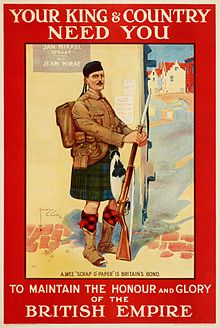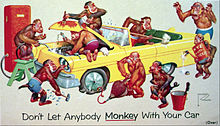Lawson Wood
Lawson Wood | |
|---|---|
| Born | 23 August 1878 Highgate, London, England |
| Died | 26 October 1957 (aged 79) |
| Other names | Clarence Lawson Wood |
| Occupation(s) | Painter, illustrator and designer |
| Spouse |
Charlotte Forge (m. 1902) |
| Children | 3 |
| Father | Lewis Pinhorn Wood |
| Military career | |
| Allegiance | |
| Service | Royal Flying Corps |
| Battles / wars | World War I |
Lawson Wood, sometimes Clarence Lawson Wood[note 1] RI FZS, (23 August 1878 – 26 October 1957), was an English painter, illustrator and designer.
Biography
[edit]
Lawson Wood was born on 23 August 1878 in Highgate, London, the son of landscape artist Pinhorn Wood RI (1848–1918),[2] and the grandson of architectural artist L.J. Wood RI,[2] (1813–1901). He studied at the Slade School of Fine Art, at the Heatherley School of Fine Art,[3] and took evening classes at Frank Calderon's School of Animal Painting.[4]: 245
In 1896, at age 18, he was employed with periodical publisher C. Arthur Pearson.[2][note 2] He soon became Pearson's chief artist, leaving after six years to turn freelance.[4]: 246
In 1902, he married the fashion artist Charlotte Forge.[4]: 246 The couple had two sons and one daughter.[5]
Work
[edit]From the age of 24 he pursued a successful freelance career and was published in The Graphic, The Strand Magazine, Punch, The Illustrated London News, and the Boys Own Paper. He illustrated a number of books including Louis Tracy's The Invaders in 1901 for Pearson.[3]

His books include The Bow-Wow Book (1912), Rummy Tales (1920), The Noo-Zoo Tales (1922), Jolly Rhymes (1926), Fun Fair (1931), The Old Nursery Rhymes (1933), The Bedtime Picture Book (1943), Meddlesome Monkeys (1946) and Mischief Makers (1946).[2] Frederick Warne of London a seried of Mr. books by Wood in 1916:Mr Prickles, Mr Quack, Mr Trunk, Mr Grunt, Mr Fox, and Mr Pup[6].
Assessment
[edit]Peppin and Micklethwait stated that Wood's wide reputation as a humorous illustrator and commercial artist was based in part on astute management. He retained the copyright in his work and licensed it in Britain and abroad for posters, postcards, etc.[7] Cran'pop was merchandised in pottery, calendars, postcards, and cigarette cards.[4]: 246 Wood worked in pen and ink, pencils, chalk, and watercolour[7]. He used a specially made enamel palette about one foot (300 mm) square and worked on Milburn Drawing Board at an architects desk.[4]: 246
Houfe said that most of Wood's work was "humorous in drawing and content, his repertoire of characters including peppery army officers, namby-pamby men and dominating old dames. The figures are heavily caricatured and he was one of the group of artists who made capital out of imaginary prehistoric scenes."[8] Kelly calls a watercolour by Wood "a welcome holiday from the prehistoric monsters and chimpanzees on which he wasted so much talent."[9] Peppin and Micklethwait cite Percy Bradshaw as saying the Wood had a "breadth, ease and fluency which many an infinitely more serious artist must envy".[7]
Later life
[edit]Wood lived in a 15th-century medieval manor house he moved brick by brick from Sussex to the Kent border. He died in Devon on 26 October 1957 at the age of 79.[2]
Notes
[edit]References
[edit]- ^ Greenwall, Ryno (14 June 1905). Artists and Illustrators of the Anglo-Boer War. Vlaeberg, Western Cape, South Africa: Fernwood Press. p. 235. ISBN 0-9583154-2-6.
- ^ a b c d e Dalby, Richard (1991). The Golden Age of Children's Book Illustration. Edison, New Jersey: Chartwell Books, Inc. p. 108. ISBN 0-7858-1427-2.
- ^ a b Smith, Jane Felecity. "Lawson Wood: Guest Biography courtesy of Jane Felicity Smith". JVJ Publishing: Illustrators. Archived from the original on 9 February 2020. Retrieved 25 August 2020.
- ^ a b c d e f Bryant, Mark (2018). Dictionary of Twentieth-Century British Cartoonists and Caricaturists. London: Routledge.
- ^ A. & C. Black Ltd. (1964). Who Was Who: Volume V 1951-1960: A Companion to Who's Who Containing the Biographies of Those Who Died During the Decade 1951-1960. Vol. 5: 1951-1960 (2nd ed.). London: Adam and Charles Black. p. 1188. Retrieved 25 August 2020 – via The Internet Archive.
- ^ Darling, Harold; Chwast, Seymour (1999). From Mother Goose to Dr. Seuss: Children's Book Covers 1860-1960. San Francisco: Chronicle Books. pp. 144–5. ISBN 0-8118-1898-5. Retrieved 25 August 2020 – via The Internet Archive.
- ^ a b c Peppin, Bridget; Micklethwait, Lucy (6 June 1905). Dictionary of British Book Illustrators: The Twentieth Centrury. London: John Murray. p. 329. ISBN 0-7195-3985-4. Retrieved 25 August 2020 – via The Internet Archive.
- ^ Houfe, Simon (1996). Dictionary of 19th Century British Book Illustrators and Caricaturists. Woodbridge: Antique Collectors' Club. p. 354. ISBN 1-85149-193-7 – via 0.
- ^ Kelly, C. M. (1975). The Brocks, A family of Cambridge Artists and Illustrators. London: Charles Skilton Ltd. p. 113.
External links
[edit]- Lawson Wood on Artnet
- Lawson Wood artworks
- Lawson Wood at Library of Congress, with 6 library catalogue records
